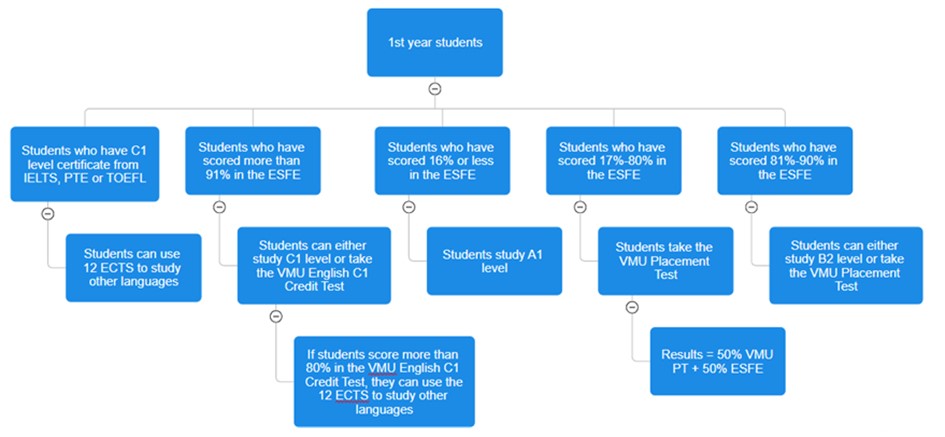Is the English Proficiency Level Always Reflected in Placement Tests?
Abstract
In today's globalized world, the importance of language learning is paramount due to factors such as international travel, work opportunities, and cultural exchange. Accurately assessing language proficiency and placing learners in appropriate courses is crucial to maximize the benefits of language education. Language placement tests serve this purpose by determining learners' starting points based on their language skills, ensuring they are appropriately challenged and motivated. These tests are widely used in educational institutions and typically cover various language skills like grammar, vocabulary, reading, writing, speaking, and listening. By placing students at the right level, language placement tests enable instructors to tailor lessons to their individual needs, fostering growth and engagement. The integration of reliable placement tests has become indispensable in language education to provide fair assessment, effective instruction, and successful language acquisition. In this article, we present the results of a survey on the reliability of placement tests from the students’ perspective. The quantitative and qualitative study with 120 respondents was conducted in the spring semester of 2023 at Vytautas Magnus University. The study aimed to explore whether the participants believed that placement tests accurately gauge their actual language knowledge and skills and if VMU English Placement Test accurately identifies suitable language proficiency levels for students. The study also sought to collect data for recommendations to improve VMU English Placement Test. According to the respondents, VMU English Placement Test efficiently determines the test takers’ language proficiency levels. Nevertheless, a definitive answer to the question of whether English placement tests reliably indicate actual English language proficiency remains open, as the responses split evenly into positive and negative viewpoints. The study also revealed that all facets of English language competence, including writing, reading, grammar, and listening, must undergo assessment through placement tests.
Downloads
References
Al-Adawi, S., & Al-Balushi, A. (2016). Investigating Content and Face Validity of English Language Placement Test Designed by Colleges of Applied Sciences. English Language Teaching, 9(1), 107-121. https://doi.org/10.5539/elt.v9n1p107
Almutairi M. A. (2023). Reliability and Validity of the Electronic English Placement Test (EPT) conducted by the Language Centre, Public Authority for Applied Education & Training. British Journal of English Linguistics, 11(3), 46-55.
Amorim, G. B. (2021). Designing Indicators for a Placement Test: Drawbacks and Affordances. Frontiers of Contemporary Education, 2(2), 67-79. https://doi.org/10.22158/fce.v2n2p67
Bachman, L., & Palmer, A. (2022). Language assessment in practice: Developing language assessments and justifying their use in the real world. Oxford: Oxford University Press. https://doi.org/10.7916/D8CV4HB8
Bahr, P. R., Fagioli, L. P., Hetts, J., Hayward, C., Willett, T., Lamoree, D., Newell, M. A., Sorey, K., & Baker, R. B. (2019). Improving Placement Accuracy in California’s Community Colleges Using Multiple Measures of High School Achievement. Community College Review, 47(2), 178-211. https://doi.org/10.1177/0091552119840705
Bernhardt, E. B., Rivera, R. J., & Kamil, M. L. (2004). The practicality and efficiency of web‐based placement testing for college‐level language programs. Foreign Language Annals, 37(3), 356-365.
Brown, J. D. (1989). Improving ESL placement tests using two perspectives. TESOL Quarterly, 23(1), 65-83. https://doi.org/10.2307/3587508
Broderick, T. (2022). What Is a College Placement Test? Retrieved from https://www.bestcolleges.com/test-prep/college-placement-test/
Bryman, A. (2016). Social research methods. Oxford: Oxford University Press.
Creswell, J. W., & Creswell, J. D. (2017). Research design: Qualitative, quantitative, and mixed methods approaches. Thousand Oaks: SAGE Publications, Inc.
Dick, K. (2023). Why is it Important to Learn a Foreign Language? Retrieved from https://www.goabroad.com/articles/language-study-abroad/why-is-it-important-to-learn-a-foreign-language
Fan, J., & Jin, Y. (2020). Standards for language assessment: Demystifying university-level English placement testing in China. Asia Pacific Journal of Education, 40(3), 386-400. https://doi.org/10.1080/02188791.2019.1706445
Fink, A. (2003). The survey handbook. Thousand Oaks: SAGE Publications, Inc., https://doi.org/10.4135/9781412986328
Green, A. (2012). Placement testing. In C. Coombe, P. Davidson, & B. O’Sullivan (Eds.), The Cambridge Guide to Second Language Assessment. New York: Cambridge University Press, 164-170.
Green, A. B., & Weir, C. J. (2004). Can placement tests inform instructional decisions? Language Testing, 21(4), 467-494. https://doi.org/10.1191/0265532204lt293oa
Hille, K., & Cho, Y. (2020). Placement testing: One test, two tests, three tests? How many tests are sufficient? Sage Journal, Language Testing, 37(3), 453-471. https://doi.org/10.1177/0265532220912412
Hughes, J. L., Camden, A. A., & Yangchen, T. (2016). Rethinking and updating demographic questions: Guidance to improve descriptions of research samples. Psi Chi Journal of Psychological Research, 21(3), 138-151.
Johnson, R. C., & Riazi, A. M. (2017). Validation of a locally created and rated writing test used for placement in a higher education EFL program. Assessing Writing, 32, 85-104.
Kibuacha, D. (2021). How to Determine Sample Size for a Research Study. Retrieved from: https://www.geopoll.com/blog/sample-size-research/
Lietuvos Respublikos Švietimo ir mokslo ministerijos įsakymas dėl užsienio kalbos (anglų, prancūzų, rusų, vokiečių) brandos egzamino programos patvirtinimo. (2014). Retrieved from https://e-seimas.lrs.lt/portal/legalAct/lt/TAD/534e3950d65011e3b272e0e81c552d38
Llosa, L., & Bunch, G. (2011). What's in a Test? ESL and English Placement Tests in California's Community Colleges and Implications for US-Educated Language Minority Students. UC Santa Cruz: Education Department. Retrieved from https://escholarship.org/uc/item/10g691cw
Naqvi, S., Srivastava, R., Al Damen, T., Al Aufi, A., Al Amri, A., & Al Adawi, S. (2023). Establishing Reliability and Validity of an Online Placement Test in an Omani Higher Education Institution. Languages, 8(1), 61. https://doi.org/10.3390/languages8010061
Osborne, J. W., & Costello, A. B. (2019). Sample size and subject to item ratio in principal components analysis, Practical Assessment, Research, and Evaluation, 9(11). https://doi.org/10.7275/ktzq-jq66
Scott-Clayton, J. (2012). Do High-Stakes Placement Exams Predict College Success? CCRC Working Paper 41. Community College Research Center, Columbia University. Retrieved from https://eric.ed.gov/?id=ed529866
Scott-Clayton, J., Crosta, P. M., & Belfield, C. R. (2014). Improving the targeting of treatment: Evidence from college remediation. Educational Evaluation and Policy Analysis, 36(3), 371-393.
Vytautas Magnus University. Study Regulations. (2021). Retrieved from https://www.vdu.lt/wp-content/uploads/2021/06/Studiju-reguliaminas-LT-05-05.pdf
Vytautas Magnus University. (2023). Vytauto Didžiojo universitetas 2022 metais. Retrieved from https://www.vdu.lt/wp-content/uploads/2023/03/2022-m.-VDU-ataskaita_web.pdf


This work is licensed under a Creative Commons Attribution 4.0 International License.
Copyright for this article is retained by the author(s), with first publication rights granted to the journal.
This is an open-access article distributed under the terms and conditions of the Creative Commons Attribution license (http://creativecommons.org/licenses/by/4.0/).









1.png)









1.png)











